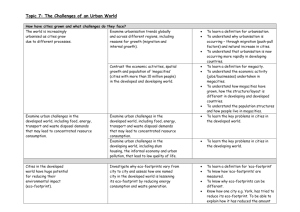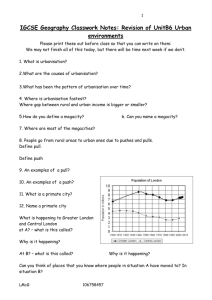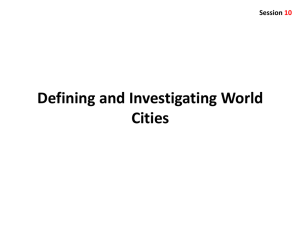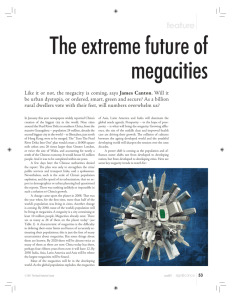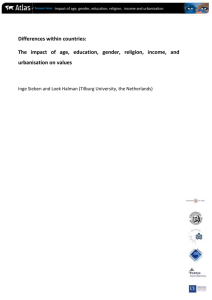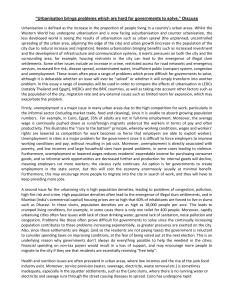Megacities, urbanisation and development The study of urban areas
advertisement
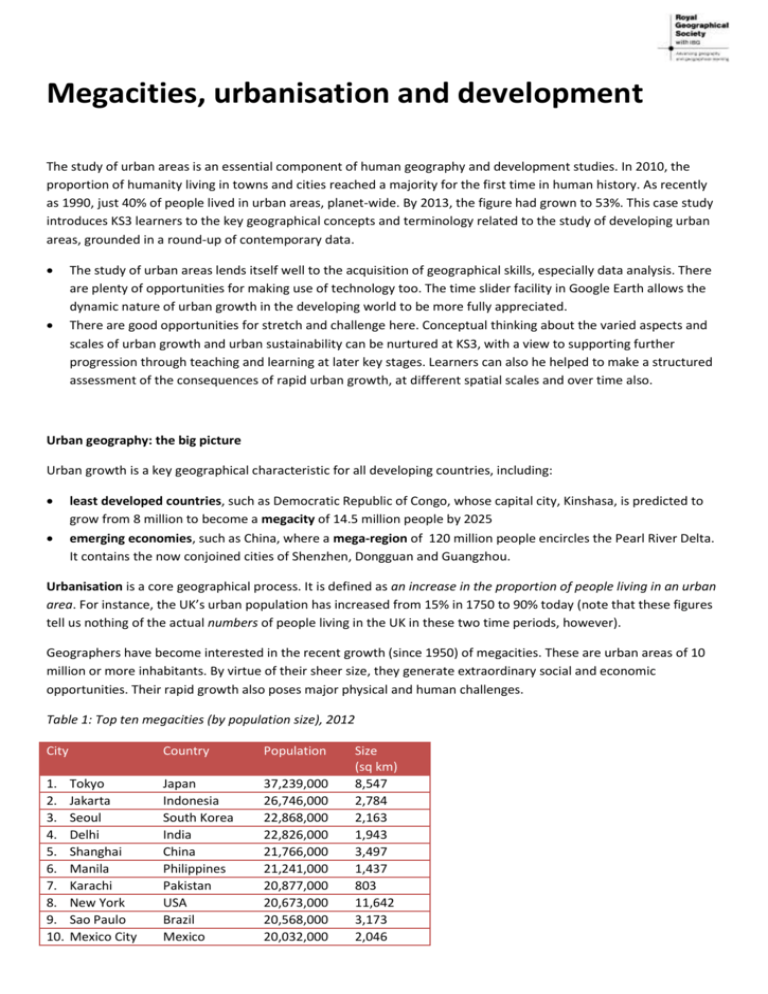
Megacities, urbanisation and development The study of urban areas is an essential component of human geography and development studies. In 2010, the proportion of humanity living in towns and cities reached a majority for the first time in human history. As recently as 1990, just 40% of people lived in urban areas, planet-wide. By 2013, the figure had grown to 53%. This case study introduces KS3 learners to the key geographical concepts and terminology related to the study of developing urban areas, grounded in a round-up of contemporary data. The study of urban areas lends itself well to the acquisition of geographical skills, especially data analysis. There are plenty of opportunities for making use of technology too. The time slider facility in Google Earth allows the dynamic nature of urban growth in the developing world to be more fully appreciated. There are good opportunities for stretch and challenge here. Conceptual thinking about the varied aspects and scales of urban growth and urban sustainability can be nurtured at KS3, with a view to supporting further progression through teaching and learning at later key stages. Learners can also he helped to make a structured assessment of the consequences of rapid urban growth, at different spatial scales and over time also. Urban geography: the big picture Urban growth is a key geographical characteristic for all developing countries, including: least developed countries, such as Democratic Republic of Congo, whose capital city, Kinshasa, is predicted to grow from 8 million to become a megacity of 14.5 million people by 2025 emerging economies, such as China, where a mega-region of 120 million people encircles the Pearl River Delta. It contains the now conjoined cities of Shenzhen, Dongguan and Guangzhou. Urbanisation is a core geographical process. It is defined as an increase in the proportion of people living in an urban area. For instance, the UK’s urban population has increased from 15% in 1750 to 90% today (note that these figures tell us nothing of the actual numbers of people living in the UK in these two time periods, however). Geographers have become interested in the recent growth (since 1950) of megacities. These are urban areas of 10 million or more inhabitants. By virtue of their sheer size, they generate extraordinary social and economic opportunities. Their rapid growth also poses major physical and human challenges. Table 1: Top ten megacities (by population size), 2012 City 1. 2. 3. 4. 5. 6. 7. 8. 9. 10. Tokyo Jakarta Seoul Delhi Shanghai Manila Karachi New York Sao Paulo Mexico City Country Population Japan Indonesia South Korea India China Philippines Pakistan USA Brazil Mexico 37,239,000 26,746,000 22,868,000 22,826,000 21,766,000 21,241,000 20,877,000 20,673,000 20,568,000 20,032,000 Size (sq km) 8,547 2,784 2,163 1,943 3,497 1,437 803 11,642 3,173 2,046 Depending on the age and ability level of students, the key urban growth concepts may be discussed further, if it is appropriate to do so. The four questions below invite students to qualify the idea of ‘urban growth’ carefully. This supports critical thinking about (i) the concept of urbanisation and (ii) development processes. Q. How is ‘urban’ defined? A. ‘Urban’ means a builtup area with a high density of population. Not all countries apply the same criteria. Q. What does ‘urban population growth’ mean? Q. In what other ways do geographers Not a study urban growth? A. It could describe the growth of a country’s percentage of city dwellers or it could mean growth in their actual numbers. A. The urban footprint of an area - how much land area it covers - is important too. Rapid footprint growth is called urban sprawl. Q. How does city growth link with the ‘big picture’ of globalisation & development? A. Some cities are world cities. Key functions (work) locate there, such as the headquarters of major global corporations. The study of urbanisation lands itself well to intensive classroom use of multimedia, including research and analysis of photographs, graphics and statistical data. Here are some possible starter exercises for KS3 urban studies. They provide immediate opportunities for geographical skill development: Visit the Guardian website and view the megacities interactive resource (supported by the Gates Foundation) at http://www.theguardian.com/global-development/interactive/2012/oct/04/rise-of-megacities-interactive The featured cities could provide the stimulus for further independent research, perhaps as a homework assignment (students can select the city they are most interested in learning more about). Undertake a Google Earth time investigation of Doha (Qatar), making use of the time slider facility. Although it is not a megacity, Doha is a world city that has grown rapidly since 2004, as the time slider shows. This can be the basis for an exercise identifying zones of rapid urban expansion, including the construction of a new airport. Find out more about making use of the time slider tool at: https://support.google.com/earth/answer/183758?hl=en Research urban growth in China, starting with the National Geographic images archived at: http://ngm.nationalgeographic.com/2007/06/instant-cities/hessler-text By one estimate, there will soon be more than 220 Chinese cities with more than one million people each. The Chinese state has built literally hundreds of instant cities from scratch in recent years, having pledged to build 400 new cities between 2000 and 2020 (this ambition was first announced in 2001). Watch excerpts the BBC television series ‘welcome to Lagos’ (2010) which is available online and gives an introductory look at urban growth in Africa. For instance, at: http://www.youtube.com/watch?v=sHKLIpz9F5c Megacity growth in numbers: the scale and rate of change The table below shows a number of key facts relating to the scale and rate of urban growth, planet-wide. It is important to help students try to grasp how these concepts (scale and rate) relate to the ways in which geographical processes operate. The information in the table below can be used to stimulate discussion. Analysis of the contents of the table - either in its existing form, or cut into cards for sorting - provides learners with the opportunity to discuss what the data are showing them about: 1. the speed at which changes occur over time (i.e. the rate of urbanisation) 2. the size and spread of urban growth (i.e. the scale of urbanisation). 3.6 billion 10 million 23 There are 7.1 billion people alive on Earth today and 53% of them live in urban areas. By mid-century, over 70% of people will be urban dwellers. In comparison, back in 1900 just one-in-five people lived in urban areas. This is the population size needed for a megacity. In reality, it can be hard to know how many people live in a city. This is due to data collection problems and disagreement over where the city boundary lies. This is the number of megacities worldwide in 2013. In 1970, there were just three: Tokyo, London and New York. By 2025, there will be 37 megacities, but neither London nor New York will be in the ‘top ten’. 11,500 sq km 1 million/week 828 metres This is the urban footprint size of New York: it covers a larger land area than any other city. But with only 20 million people (far fewer than Tokyo) it has the lowest population density of any megacity. Dhaka is densest. This is the number of people that move from rural to urban areas every week, worldwide. It has slowed slightly from a peak of 1.2 million/week in 2005, due to falling birth rates in rural areas almost everywhere. This is the height of Burj Khalifa, a skyscraper in Dubai in United Arab Emirates. Dubai is a small city of just 2.1 million people, covering a land area of 4,100 sq km. But thanks to its tower, it is the world’s tallest city! 1,000,000,000 37 million 98 per cent One billion urban dwellers live in poverty. This is linked with a range of economic and social problems such as poor housing, low pay and poor working conditions. This is the population of Tokyo, the world’s most populated megacity. Tokyo has held the top position for nearly 60 years. In China, the Hong Kong-ShenhzenGuangzhou ‘mega-region’ holds 120 million people. Despite 90% of British people living in urban areas, 98% of the UK is free of housing and development. Most of this is called ‘rural’ land. It is interesting to reflect on how little land is needed to provide so many homes. Homework suggestion Ask students to research ‘ten urban facts’ that relate to urban growth around the world (they can choose any information they want - do not provide too much guidance). In the following lesson, get them to work in groups (1) pooling their facts together and then (2) categorising the facts using the following headings: descriptions; causes (explanations); consequences (impacts); management; other. This may prompt them to reflect on what differing kinds of information they have selected for themselves under the umbrella topic heading of ‘urban facts’. By working independently in groups, with the teacher as facilitator, they should quickly identify for themselves the crucial difference between, say, a cause and a consequence. Urban facts (homework assignment) There are 23 megacities Cities are growing at 200,000 people a day as people leave the countryside London has a ‘Boris Bikes’ scheme to try and help solve traffic congestion Type of fact A description Includes a cause, or explanation This is a consequence of urban growth, or an example of management This task helps prepare KS3 students for the rigour of KS4 geography. GCSE examination success (or failure) can hinge on correct command word interpretation. Is urbanisation always a good thing? Students can be guided to think in a structured way about the positive and negative impacts of urbanisation. This will help each learner to build his or her capability to think conceptually, even at this early key stage. At later key stages, high-attaining students would be expected to produce a carefully structured answer to the question posed here (‘Is urbanisation always a good thing?’) without further prompting. Valuable groundwork can be undertaken at this key stage, working in an urban context, to help students acquire important procedural knowledge. For instance, the table below contains a number of statements that can simply be sorted into ‘positives’ (opportunities) and ‘negatives’ (challenges). However, it is also possible to further sub-divide these impacts, or consequences, into: local and global challenges/opportunities short-term and long-term challenges/opportunities physical or human challenges Basic structuring Positive/ opportunity Complex structuring Global Physical Local Economic Short-term Social Long-term Social Negative/ challenge Global Environmental Local Physical Impacts / consequences of urban growth Carbon footprint reduction It might be better for the world as a whole for most people to be living in high-density urban areas where public transport is easily available. In contrast, people who live in rural areas may make greater use of polluting motorcars to get to work or the shops. ‘Snowballing’ economic growth Once a particular city reaches a certain size, it gains the threshold population needed for certain services, such as hospitals or a sports stadium, to be built. In turn this creates more jobs and attracts even more migrants. This is called a multiplier effect. London has been described in this way, draining jobs and opportunities from other parts of the UK. Poverty reduction Although recent arrivals in the city may live in poor conditions, these conditions may be an immediate improvement on life in the countryside they have left behind. Increasing human development As time passes, urban growth can give rise to improved quality of life. Greater numbers of people could be able to attend school. Their human rights may be more easily protected. Rural populations can be harder to police and to provide services to. Consumption increases in urban areas People have much easier access to manufactured goods sold in shops and can earn the money they need to purchase more. In every continent, urban growth goes hand-in-hand with the rise of a consumer society. Polluted cities Terrible photochemical smog conditions can be found in some cities, such as Los Angeles. According to one estimate, the smog in Beijing (China) reduces people’s life expectancy by as much as five years. Short-term Complex Long-term Physical Sweatshop exploitation Recent migrants to cities in the developing world often endure poor working conditions and low salaries in ‘sweatshop’ factories. (However, over time their children may demand better treatment. Work conditions and pay have improved over time in cities across the world, from London to Jakarta.) Water insecurity It has not happened yet, but in the future, water shortages may strike cities in Asia and Africa. When large numbers of people migrate to a single place, it puts stress on resources. One day, the Nile may no longer meet the needs of Cairo’s growing population. Managing cities for a sustainable future What are the best urban management case studies to use when there are so many interesting cities and initiatives to choose from? In deciding which case studies to use, it is good practice to select examples that highlight: the diversity of cities and challenges [Conditions in a city in an emerging economy such as China may be very different from those in a city in a poorer African country like Kenya.] the local balance between rich and poor segments of society [‘Two-speed’ cities show a highly visible divide between rich and poor urban zones, such as the divides seen in Mumbai or Lagos.] the failure of some strategies to help poor segments of society to achieve development [It’s a universal problem, from Barcelona and London to Mumbai and Nairobi. Slum clearances and gentrification do not necessarily rid a city of poverty: instead, poverty becomes relocated. For instance, a £20 billion development programme known as Vision Mumbai led to the bulldozing of many slum areas, leaving 350,000 people homeless.] Case study 1: Tackling urban poverty at street level in Bangalore, India Case Study 2: Building new ‘smart cities’ in developing countries Bangalore is a city of 9.6 million people (2013). It is home to India’s call centre industry and so is often hailed as a ‘success story’ of globalisation. In one important way, developing countries have an advantage. When it comes to city planning, they can leap-frog over the older designs that plague planners in London and New York (think of Victorian houses, with their poor energy efficiency, or out-dated sewer systems and underground railway lines that are 100 years old!). ‘Retro-fitting’ new technologies, such as broadband or solar power, to existing cities is expensive: great care has to be taken not to damage existing buildings. But there is another side to the city. Poverty in the city’s eight poorest slums is deep and persistent. People live in poor conditions, in timber homes with plastic sheet roofs. Migrants from the countryside may have lower levels of education and this may lead them to lower income jobs. Whereas city planners in richer parts of the developing world can design new cities from the outset to be hitech, sustainable places. They can employ the very latest technology. Sometimes called eco-cities, or smart A new award-winning strategy is helping Bangalore’s cities, such settlements are designed to be energyslum dwellers. The Parinaam Foundation funds the Urban Ultra-Poor Programme (UUPP). Key to its success efficient and fully networked, with computers that allow is a ‘bottom-up’ approach. This sees researchers working intelligent control of traffic and services. with local people to find out what kind of help they need Sometimes an entire new city is built, or else a ‘gated most if they are going to escape poverty. settlement’ is constructed as a satellite town near an existing city. Masdar is a planned eco-city in the Middle In some slum areas, surveys revealed childcare or particular health worries as dominant concerns. In another, women told UUPP researchers their husbands wouldn’t let them go out and find work, which restricts their ability to earn and provide for their families. So the UUPP team focused on helping the women learn basic skills they can use at home, such as candle making or sewing quilts. ‘We have to admit that the adults in these slums are never going to be lifted entirely out of poverty... It is only the children who will truly lift their parents so we need to focus on them too, ’ say UUPP. Find out more: http://www.ft.com/cms/s/0/8e5c7f6648a7-11e3-8237-00144feabdc0.html#axzz2orCWyzMP East with intelligent design of buildings, amenities, public transport systems, cycle-ways, water utilities and recycling facilities that can contribute to sustainability goals such as carbon-neutral, zero-waste living. Find out more at: http://www.masdar.ae/en/home/index.aspx New gated developments in Africa on the outskirts of Nairobi, Kampala and Kinshasa all feature shopping malls, golf courses and new hi-tech mansion-style housing. Find out more at: http://www.newstatesman.com/2013/11/petropolisnow Plenary: achieving urban sustainability This study of megacities, urbanisation and development concludes with a brief discussion of what sustainable development really means in an urban context. For the benefit of future generations, the environment should be protected. Yet people’s housing and employment needs must simultaneously be catered for (and bear in mind this may be a rapidly growing population, measured year-on-year). Students can complete their urban development study by exploring questions such as: Will urban sustainability ever be achieved on a global scale? How might it be achieved? Is urban sustainability more easily achievable for a city located in the UK than it is for one in developing parts of Africa or Asia? Is urban sustainability easier for a smaller city to achieve than it is for a megacity to achieve? As extra reading, look at: http://www.theguardian.com/sustainable-business/urban-sustainability-smart-city-future

